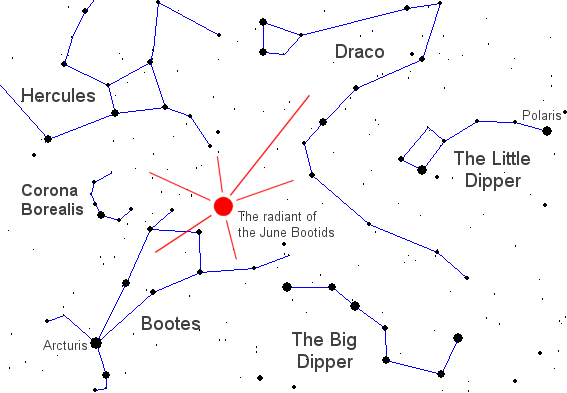 Quick Facts:
On June 27th, 1998, northern sky watchers were surprised when meteors suddenly began to stream out of the constellation Bootes. Observers saw as many as 100 meteors per hour during the 7-hour-long outburst. It wasn't the first time: similar outbursts from Bootes had been recorded in 1916, 1921 and 1927. Astronomers call these unpredictable meteors the June Bootids. The source of the June Bootids is comet 7P/Pons-Winnecke, which orbits the Sun once every 6.37 years. The comet follows an elliptical path that carries it from a point near the orbit of Earth to just beyond the orbit of Jupiter. Pons-Winnecke last visited the inner solar system in 2002. The comet's tail is evidently clumpy. When our planet passes through a dense spot in the debris stream, a meteor shower erupts. Meteor forecasters D.J. Asher and V.V. Emel'yanenko (MNRAS 331, 1998, 126) have calculated that the comet dust seen in 1998 (trapped in the 1:2 mean-motion resonance with Jupiter) might return in 2003, although 2004 is more likely. That's why watching for June Bootids this year is important: any activity now may herald another outburst in 2004. The shower's peak in 2003 is expected to occur on Friday, June 27th near 1930 universal time (3:30 p.m. EDT). This timing favors the Middle East, Southeastern Europe and southern Asia. North Americans might see some meteors hours after the nominal peak. Step outside after sunset on Friday and look straight up. The constellation Bootes and the radiant of the meteor shower will be almost directly overhead:  Above: This image shows the area of sky around the June Bootid radiant, indicated by a red dot. At 10 p.m. local time on June 27th, the radiant will be directly overhead as seen from mid--northern latitude observing sites. |